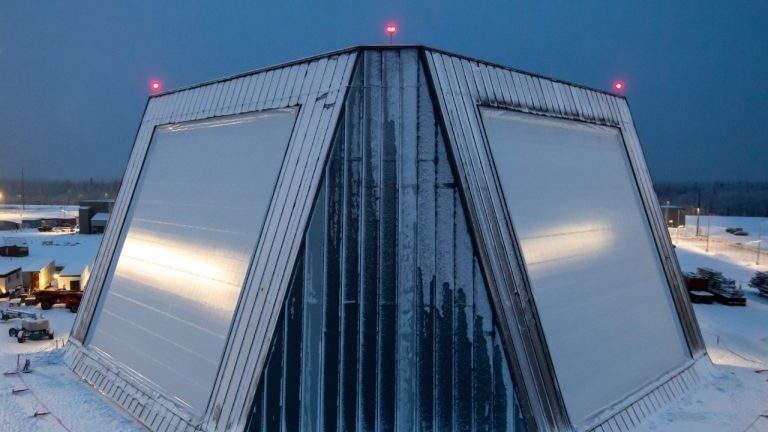
The Long Range Discrimination Radar (LRDR) will be transfered to the Space Force for operations in FY25, according to the Missile Defense Agency’s budget request. (Photo: Missile Defense Agency)
WASHINGTON — The Missile Defense Agency’s fiscal 2025 budget request seeks $10.4 billion, down $500 million from its FY24 request.
MDA did not provide its usual background briefing to reporters on its budget, but did make available a fact sheet of major highlights. The fact sheet did not, however, break out planned research and development spending from procurement spending.
Defense of Guam continues to be a key focus for MDA in FY25, with a total of $1.2 billion requested for the overall program — an increase from $801.7 million requested in FY24. The fact sheet explains that the funds will “continue development and procurement of the Aegis Guam System and Vertical Launch Systems; and complete environmental impact studies and begin construction of Command Center Complex supporting missile defense command and control components, a Transportable Array Unit (TAU) Complex, and a launcher field complex.”
The agency’s FY25 request for one of its newest efforts, the Glide Phase Interceptor (GPI) designed to shoot down hypersonic missiles in their glide phase prior to when they commence high-speed maneuvers, slips slightly to $182 million from the FY24 request of $209 million.
In November 2021, Raytheon was awarded $20.97 million; Lockheed Martin $20.94 million, and Northrop Grumman $18.95 million for GPI development. Lockheed Martin was knocked out of the competition last June, when the agency granted Northrop Grumman and Raytheon firm-fixed price contract modifications worth more than $41.4 million to continue developing their proposals.
Following President Joe Biden’s first trilateral summit in August with the leaders of Japan and South Korea, the Defense Department has been working on a formal agreement with Japan’s Defense Ministry on joint GPI development.
THAAD Up; GMD, Aegis, C2BMC Down
MDA’s FY25 ask of $732 million in total for the Terminal High Altitude Area Defense (THAAD) defense system also jumps up from its FY24 request of $457 million. The request is slated to “continue the development of THAAD system builds to increase Interceptor capability and weapon system performance to address the current and evolving threat, to include significant improvements which will provide the capability to counter more advanced threats; procure 12 THAAD interceptors; and begin initial engineering efforts supporting integration of the THAAD weapon system into the Army Integrated Air and Missile Defense Battle Command System (IBCS) architecture,” the fact sheet explains.
The agency’s FY25 request for Ground-based Midcourse Defense (GMD) efforts, on the other hand, took a not insubstantial cut to $2.7 billion from the $3.3 billion asked for in FY24. The biggest GMD project is the Next-Generation Interceptor development, which in FY24 was budgeted at $2.1 billion. The MDA fact sheet for FY25 does not break out the request for NGI, however.
Likewise, the FY25 request for Aegis Missile Defense shows a dip, from $1.6 billion in FY24 to $1.2 billion in FY25. The funds will include procurement of 12 SM-3 Block IIA missiles and “critical SM-3 Block IB spares,” but there will be “no SM-3 Blk IB missile procurement in FY25,” the fact sheet explains. The request further covers “additional software capability development to upgrade IAMD [integrated air and missile defense] performance in Aegis ships, to include integration of missile defense capability with AN/SPY-6 radar for enhanced engagement capability and increased raid capacity.”
The Command, Control, Battle Management and Communication (C2BMC) effort, which according to MDA’s FY24 budget documents “provides the capability for persistent acquisition, tracking, cueing, discrimination, and distribution of fire-control quality data” to interceptor platforms across all domains located in both the homeland and US regional commands, also took a small hit.
MDA asked for $517 million for C2BMC in FY25, versus $554.2 million in FY24. The FY25 fact sheet explains the request is slated “to develop expanded hypersonic threat tracking and integration of space sensors to warn, track and type advancing threats and sustain the latest deployed C2BMC capability spiral (8.2.5) which includes LRDR support tasking for GMD homeland defense engagements, initial hypersonic threat tracking and AN/TPY-2 Space Domain Awareness (SDA) for Combatant Commands and initiate C2BMC hardware obsolescence upgrades.”
Radars, Radars, Radars
The request includes $105 million for the Long Range Discrimination Radar (LRDR), slightly more than the $103.5 requested in FY24. LRDR has been deemed a critical capability by US Northern Command (NORTHCOM)/NORAD leaders in providing domain awareness of adversary missile attacks on the American homeland.
That S-band radar’s primary purpose is to distinguish between intercontinental ballistic missiles launched by adversarial nations towards the US and decoys or other innocuous objects moving through space. In addition to protecting the country from a legitimate attack, the capability to differentiate between real threats and decoys helps to preserve the Pentagon’s precious supply of interceptors. It also is designed to keep better tabs on jinking hypersonic missiles.
While NORTHCOM had been hoping the LRDR would be able to start operations in FY24, MDA’s fact sheet shows that the system won’t transfer to the Space Force for operations until FY25.
Other radar efforts in the FY25 request are:
- AN/TPY-2 radar: $587 million “to upgrade and sustain 12 radars, continue production of 1 additional radar to deliver in FY25 (total of 13) and continue upgrades to improve discrimination capabilities.” MDA asked for $568 million in FY24.
- Sea-Based X-band Radar (SBX): $197 million, up from $177.9 million in FY24, “to continue operations at sea and radome replacement.”
- COBRA DANE and the Upgraded Early Warning Radars: $22 million “to continue sustainment in partnership” with the Space Force, the same amount as requested in FY24.






















